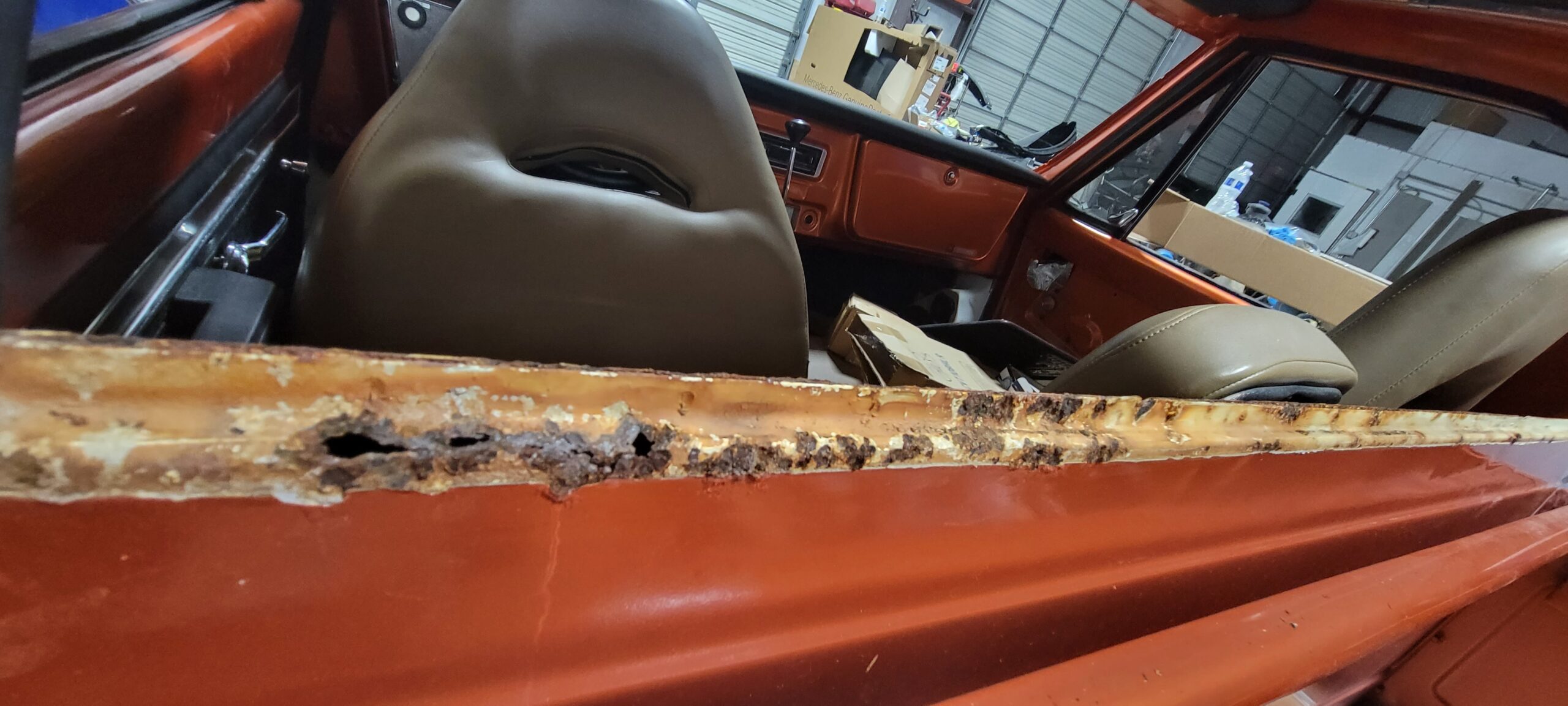Rust, the silent enemy of any vehicle, slowly eats away at the metal surface, compromising its beauty, strength, and value. It hides under rubber and chrome moldings. Repairing Rust Damage is like Cancer, if you don’t get it all, it will come back with a vengeance.

Understanding the Causes of Rust
What is rust exactly? Rust or iron oxide is the result of a chemical reaction where iron (or iron-based metals) and oxygen react in the presence of water or moisture. This process, also known as the oxidation process, can spell disaster for your car over time. As the rust forms, it can damage the metal, thus decreasing its tensile strength, and eventually leading to holes and severe structural damage.
So, what culprits push iron-based metals toward this red menace?
Road Salt
One major factor is the presence of road salt. If you live in colder regions where salt is regularly used to melt ice on the roads, your vehicle is more inclined to rust. Salt accelerates the rusting process by lowering the threshold for the chemical reaction to occur, especially when combined with water or moisture.
Moisture
Moisture, in general, can speed up the rusting process. Whether it’s caught in your wheel wells or resting on your body panel, moisture can set the bare metal on the fast track to developing rust spots. Not just any moisture, but even salt water or bird droppings can also create conducive conditions for rust formation.
Here in the Houston area we have high humidity, and that can cause exposed metal to start to rust in 3 days or less. In our body shop we cannot leave a car we have sanded to bare metal without primer for even 24 hours as the rust will start forming that fast.
While rust can affect virtually any part of a car that’s made of ferrous metal, certain areas are more susceptible. For example, brake pads, wheel wells, and body panels often come into direct contact with road salt and trapped water, making them vulnerable to rust.
Understanding the Stages of Rust

Now that we know how rust forms and what accelerates its build-up, the next course of action is to learn how to identify its early stages. Whilst rust may seem inconspicuous at the offset, it will invariably reveal itself over time, as it undermines the integrity of your vehicle’s bodywork. Repairing Rust Damage is critical to keeping your car in good condition.
Surface Rust
Surface rust is often the first stage and easiest to spot. As the name suggests, surface rust forms on the exterior surface of your vehicle when your paint or protective layer is breached. This can expose the ferrous metal underneath, starting the corrosion process. You may notice small flecks of brownish-red on your car’s paint, or spots where the paint is bubbling– a clear indicator of rust forming beneath.
Scale Rust
The scale rust is the next stage, where the rust forms and starts to pit the metal, leading to visible rust spots on your car body. Scale rust can be recognized by the rough texture it casts on the previously smooth metal surface. At this point, your car will interiorly start to degrade, and if not taken care of, may lead to structural damage.
If scale rust is left untreated, it eventually evolves into the most destructive stage of rusting—rust holes. At this stage, the rust has eaten through the metal, leading to holes. Rust holes, especially on body panels near the suspension components or battery terminal, can cause severe damage and safety concerns.
Rust Holes
If scale rust is left untreated, it eventually evolves into the most destructive stage of rusting—rust holes. At this stage, the rust has eaten through the metal, leading to holes. Rust holes, especially on body panels near the suspension components or battery terminal, can cause severe damage and safety concerns.
However, the good news is that identifying the signs of rust early can make a world of difference and, with our regular inspection, help mitigate any serious damage.
Repairing Rust Damage
The best away to combat the horribly corrosive effects of rust is to prevent it from forming altogether. Car owners should be advised to wash their cars regularly to remove corrosive substances such as dirt, salt, and grime, which can trap in the moisture that accelerates the rust-forming chemical reaction. The underside of the car mustn’t be neglected, as the frame, suspension, and wheel wells are all prime rust-invasion zones. Regular waxing is also recommended for providing the paint coat with an added protective layer against nicks and scratches.
Rust can be a nightmare, with its damaging effects often leading to costly repairs. Owners should remain vigilant about checking their cars for the first signs of rust, so the car can be quickly treated with touch-up paint or taken into the auto body repair shop for closer inspection.
By now, we’ve acquainted ourselves with the causes of rust and how to spot its early signs. While curing rust is necessary, preventing it from forming in the first place is even more cost-efficient. Remember, the key to rust prevention is to keep the metal on your vehicle from coming in direct contact with water, salt, and other harmful contaminants.
Regular inspections can play a vital role in rust prevention. Become familiar with areas of your car that are particularly prone to rust like:
- Brake pads
- Battery terminals
- Body panels
- Wheel wells
- Any other areas that frequently face water and road salt.
Regularly look out for subtle signs such as paint bubbling or rust spots to address the issue early on.
Rust-proofing is another highly effective strategy. Various products in the market like rust-proofing sprays and rust inhibitors are specifically designed to provide a protective layer on your car’s surface. This shields the iron-based metal from moisture, salt water, and other elements that hasten rust formation.
Wash Your Car
Considering the detrimental impact that trapped salts can have on your car’s metal surface after a snowy day or a beach visit, giving your vehicle a regular car wash is advised. Washing undercarriage, can greatly reduce the potential for rust build-up.
Moreover, a high-quality, rust-resistant paint job can also dramatically decrease the chances of rust formation. You can also consider using materials like stainless steel for portions of your car that are at high risk for rust development.
Rust and corrosion occur when moisture comes into contact with metal, leading to the breakdown of the metal’s surface. The process is accelerated in humid environments, making it a significant risk for vintage and luxury cars stored in garages, sheds, or warehouses. Rust and corrosion can lead to serious damage to the car’s body, chassis, and engine, reducing its value and requiring expensive repairs.
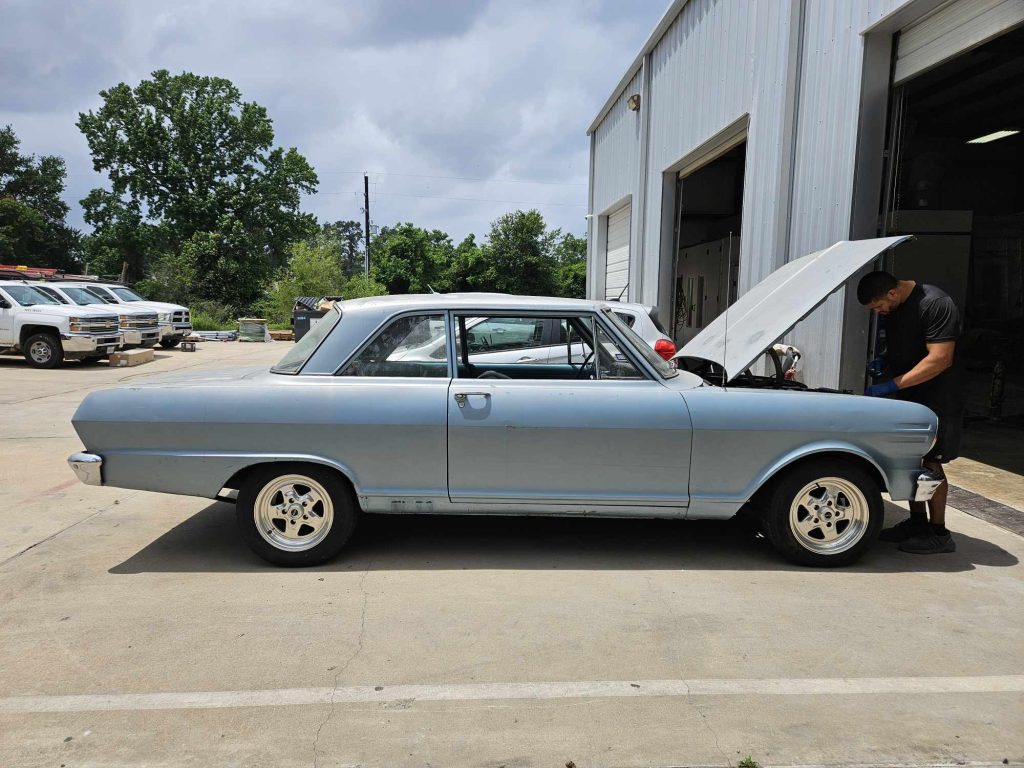
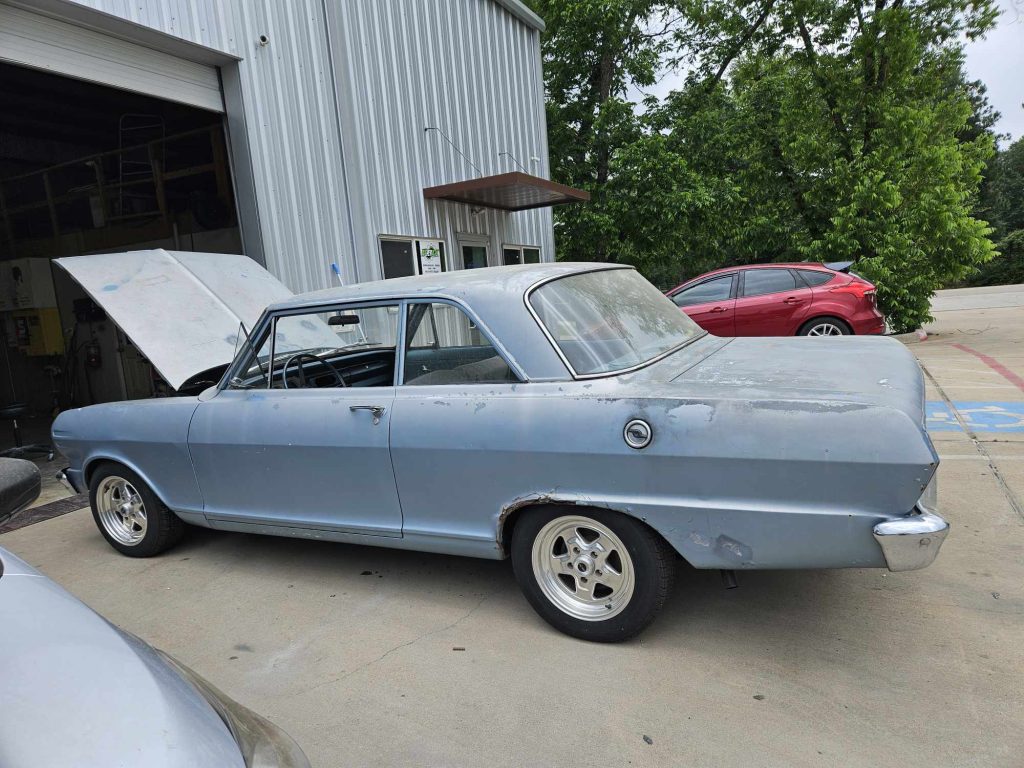
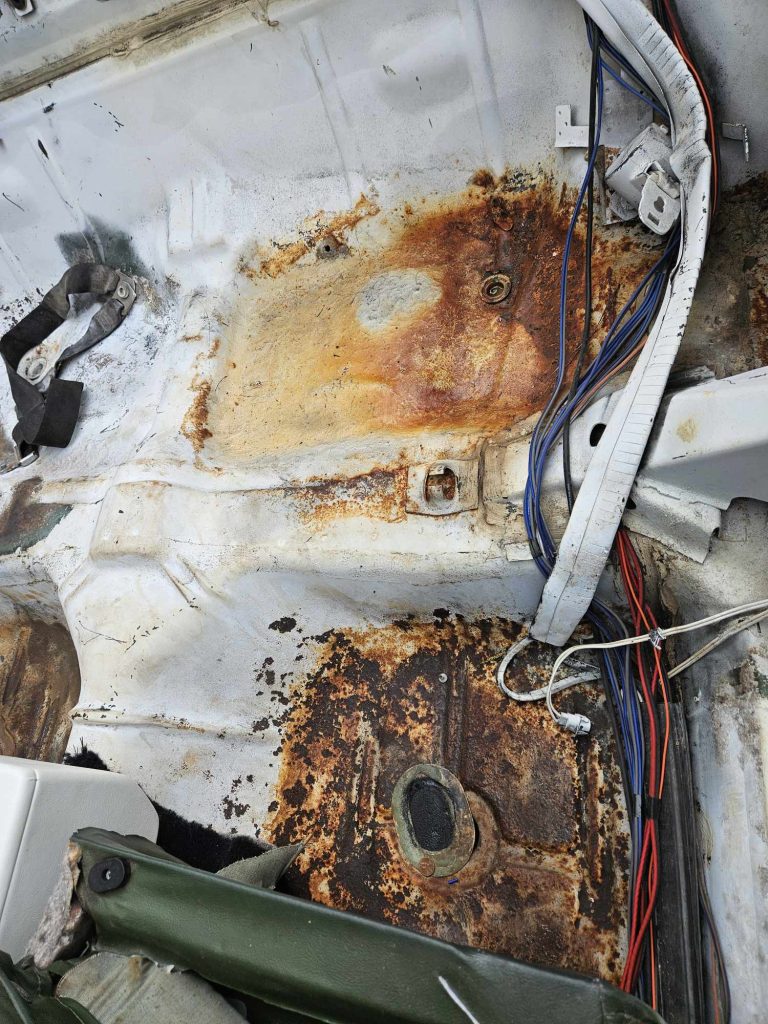
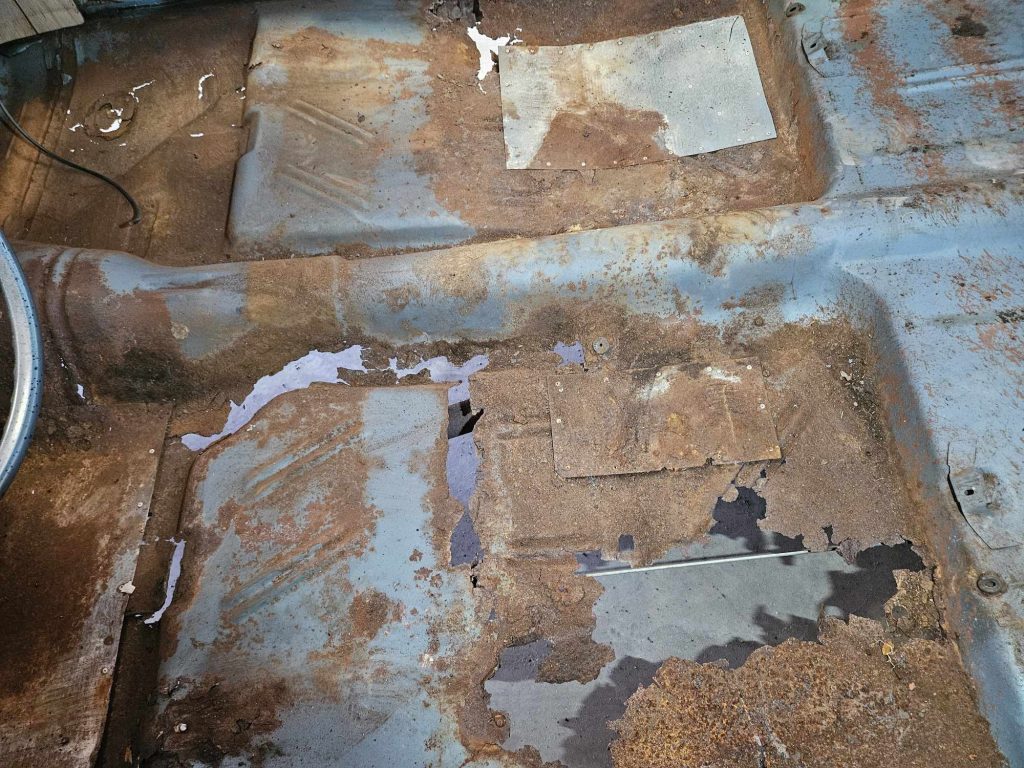


Fortunately, it is possible to prevent rust and corrosion by controlling the moisture levels in the storage area.
Here are some tips on how to do so:
Store the car in a dry place:
The first step in preventing rust and corrosion is to store the car in a dry place. This could be a climate-controlled garage or a storage unit with dehumidifiers. Avoid storing the car in a damp basement or outside where it is exposed to the elements.
Use desiccants:
Desiccants are substances that absorb moisture from the air, making them an effective tool in preventing rust and corrosion. Silica gel packets, for example, can be placed inside the car or around the storage area to absorb moisture and keep the air dry. There are many products available now designed to draw moisture out. They are available online and in auto parts stores.
Seal the storage area:
If the storage area is not completely sealed, moisture can seep in and create a humid environment. Seal any cracks or gaps in the walls, floor, or ceiling to prevent moisture from entering.
Maintain proper ventilation:
While it is important to seal the storage area, it is also important to maintain proper ventilation to allow air to circulate. This can help prevent condensation from forming, which can lead to rust and corrosion. Consider installing a ventilation system or opening windows and doors periodically to allow fresh air to circulate.
Keep the car clean and dry:
Finally, keeping the car clean and dry is essential in preventing rust and corrosion. Wash and dry the car thoroughly before storing it, and check for any signs of moisture or damage periodically.
Call Us for Help!
We specialize in repairing rust damage on vehicles. when we repair rusted problem areas, we remove the physical rust, and treat the bare metal to stop any further rust. Sometimes this requires replacing the damaged area with new metal. We then seal it up so no more damage will occur. We DO NOT EVER paint over rust!

